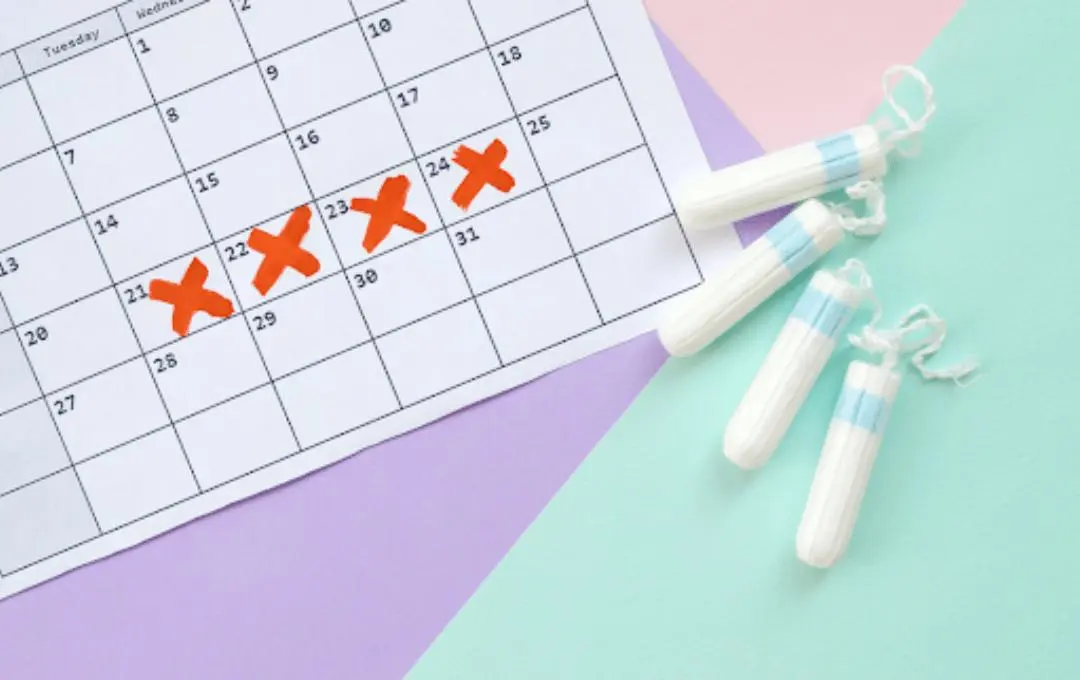
Bleeding between periods can be a sign of an underlying health issue, such as uterine fibroids. These non-cancerous growths can lead to several symptoms, including abdominal cramping, pelvic pressure, abnormal bleeding and spotting between periods. Spotting differs from menstrual bleeding in flow, color, and duration. While spotting may occur before or after a period, it is often a sign of menstrual cycle irregularities caused by fibroid growth.
Understanding these symptoms is important for seeking the proper treatment. USA Fibroid Centers specialize in diagnosing and treating fibroids, offering comprehensive screenings and personalized treatment plans to help patients find relief. Before your consultation, our symptom checker can provide additional insights into whether fibroids may be causing your symptoms.
Causes of Bleeding Between Periods
Spotting between periods is a common symptom of various conditions. However, due to the commonality of fibroids among women of reproductive age, consulting with a fibroid specialist can help clarify your condition.
Some of the potential causes of bleeding between periods include:
- Hormonal imbalance
- Birth control
- Ovulation
- Uterine fibroids
- Vaginal or cervical injury
- Sexually transmitted disease (STD)
- Pelvic inflammatory disease (PID)
- Polycystic ovary syndrome (PCOS)
- Endometrial, Uterine, or Ovarian Cancer
Many of these health conditions have effective treatments to reduce or eliminate bleeding between periods. If you experience frequent or heavy spotting, consult a fibroid specialist for an evaluation. Fibroid specialists can determine if fibroids are causing the bleeding and assess their size and location through imaging tests to guide you toward the most appropriate treatment plan.
Why Do Fibroids Cause Bleeding Between Periods?
Uterine fibroids can significantly disrupt menstrual patterns, leading to spotting between periods.
Uterine fibroids can vary in type, location, and symptoms that alter the uterine lining, disrupt its shedding, and exert pressure that prevents the uterus from stopping bleeding. Fibroids may also increase the blood supply to the uterus, creating fragile blood vessels.
Fibroids also cause hormonal imbalances that lead to heavier periods and intermenstrual bleeding, or bleeding that occurs between regular menstrual periods, ranging from light spotting to heavy flow. While some individuals experience no menstrual changes, others may face prolonged or heavy periods lasting weeks or even months.
Types of Fibroids That May Cause Bleeding

The specific types of fibroids most likely to cause bleeding between periods are:
- Intramural Fibroids: This type grows within the muscular walls of the uterus and can affect the endometrial lining. Small intramural fibroids may cause mild symptoms, but larger ones often cause heavy periods lasting over 10 days, irregular bleeding, and pelvic or lower back pain.
- Submucosal Fibroids: These fibroids are the most likely to cause bleeding between periods since they are inside the uterine cavity and disrupt the endometrial lining. They often cause heavy menstrual bleeding, frequent or large blood clots, anemia, fatigue, and pelvic discomfort.
Each fibroid type can significantly affect menstrual health and requires proper diagnosis and management for symptom relief.
Symptoms to Look Out For Related to Fibroids and Bleeding Between Periods
Fibroids and bleeding between periods can raise questions about the difference between spotting and periods, prompting concerns about what spotting means and whether it is normal.
Abnormal bleeding caused by fibroids may include:
- Heavy menstrual flow: Bleeding through tampons or pads every hour or two.
- Spotting between periods: Light bleeding or brownish discharge occurs unexpectedly outside your cycle.
- Prolonged bleeding: A menstrual period lasting longer than the typical seven days.
- Pelvic pain or pressure: Sharp or dull aches and pain in the pelvic area, sometimes spreading to back pain.
If you experience persistent spotting or abnormal bleeding patterns, it could indicate an underlying issue like fibroids.
When to See a Doctor for Fibroid-Related Bleeding
If there are changes in your menstrual cycle, such as persistent spotting, longer or shorter periods, or increased pain, consult a doctor for consultation. A thorough evaluation, including a detailed health history, pelvic examination, and imaging tests, may be required for an accurate diagnosis.
Immediate medical attention is necessary if you experience symptoms like:
- Spotting or bleeding after sex
- Frequent spotting between periods
- Unusual vaginal discharge
- Strong odors
- Vulvar irritation
- Pain during sex or urination
- Pelvic pain
- Fever over 100.4°F.
Fibroids causing spotting and bleeding between periods can significantly disrupt daily life, leading to missed work, strained relationships, and disruptions to normal activities.
USA Fibroid Centers provides non-surgical treatments like uterine fibroid embolization (UFE) to manage those problematic symptoms and improve patient’s quality of life. If you’re unsure whether fibroids are the cause, schedule a health screening with one of our fibroid experts at a clinic near you today.
Schedule Your Appointment for a Diagnosis
How to Stop Fibroid Spotting or Bleeding
Fibroid-related bleeding can often be managed with non-invasive and minimally invasive treatments tailored to your symptoms and overall health. For many, hormonal birth control methods, such as pills, patches, or intrauterine devices (IUDs), provide relief by regulating menstrual cycles and reducing fibroid bleeding. While these options can effectively manage symptoms, they do not address the fibroids themselves.
Treatment Options for Uterine Fibroids Bleeding Between Periods
If your bleeding between periods is due to fibroids, uterine fibroid embolization (UFE) may be effective in eliminating your symptoms. This outpatient procedure blocks the blood supply, causing fibroids to shrink naturally. Unlike surgical procedures, UFE preserves the uterus and does not require surgery, so it has a quick recovery time.
Our fibroid specialists, also known as interventional radiologists, treat fibroid symptoms such as spotting between periods.
Talk to a Fibroid Specialist Today
How to Temporarily Manage Fibroid Bleeding Between Periods Until Treatment

While awaiting fibroid treatment, there are ways to manage bleeding between periods temporarily.
Some of these temporary solutions include:
- Staying healthy through diet and exercise
- Stress management
- Tracking menstrual cycles and spotting patterns
- Over-the-counter pain relievers may ease mild cramping
- Wearing panty liners between periods
These are temporary measures, though, as fibroids causing bleeding between periods require medical intervention to address the underlying causes. Treatments like uterine fibroid embolization (UFE) will provide long-term relief by targeting the root cause of your symptoms: fibroids.
Discuss Your Symptoms with a Fibroid Expert
Bleeding between periods can have various causes, and it’s essential to get a proper diagnosis. If you are concerned about your bleeding patterns, we recommend discussing your symptoms with a fibroid expert at USA Fibroid Centers. They can help determine what’s causing your irregular bleeding pattern and recommend the best course of action for your individual situation.
Our team is dedicated to providing comprehensive healthcare for women. USA Fibroid Centers has over 40 state-of-the-art facilities nationwide, and treatments are covered by most insurances, including some Medicaid and Medicare plans.
If you’re interested in learning more about uterine fibroids and the non-surgical treatments for them, schedule an appointment online or call us at 855.615.2555. You can also use our location finder to see which of our locations is closest to you.
FAQs
How do I Know if Fibroids Cause My Spotting?
Spotting related to fibroids often occurs irregularly between periods and may be accompanied by heavy menstrual bleeding, prolonged periods, or large blood clots. Pelvic discomfort, such as pressure or pain in the lower abdomen, and pain during intercourse can also be signs of fibroids.
Does Treating Fibroids Stop Bleeding Between Periods?
Treating uterine fibroids can stop bleeding between periods by addressing the root cause of the abnormal bleeding. Options such as uterine fibroid embolization (UFE) shrink the fibroids, reduce the tissue that causes bleeding, and alleviate fibroids that cause bleeding between periods.
Is Spotting Between Periods Normal?
Occasional spotting between periods is not always a reason for concern and is often linked to hormonal fluctuations from ovulation, stress, or changes in birth control, diet, or exercise. However, persistent, heavy, or frequent spotting, especially if accompanied by pain or unusual discharge, should be evaluated by a doctor.
How Long Does Fibroid Spotting Last?
Unlike typical spotting, which usually lasts a day or two, fibroids that cause bleeding between periods can lead to persistent bleeding for several days or weeks. It can occasionally progress to heavy bleeding, especially if the fibroid is large or near the uterine lining. If spotting becomes excessive or leads to anemia symptoms like fatigue or dizziness, it’s essential to consult a doctor.



